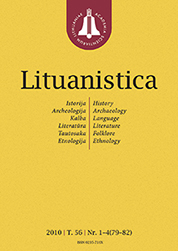LituanisticaWHAT?
 ISSN 0235-716X |
2006 m. Nr. 3 Lietuvos folklorinių ansamblių koncertinė apranga: etninio tapatumo aspektai
The wearing of national costume is a special means of declaring one’s ethnocultural identity. One of the methods of ethnic self-expression is the creation of national costumes. The author seeks to determine the importance of the creation and wearing of concert attire in Lithuanian folklore ensembles for the ethnic self-consciousness of ensemble members, the concert attire of ensemble varying from absolutely authentic national costumes to scenic dress made from modern material and in contemporary design. Six categories of concert dress of folklore ensembles were established according to the decreasing order of authenticity. Authentic dress wearing 2 (2.6%), national costume 54 (72.0%), dress reconstructed according to archaeological or historical sources 4 (5.3%), ethnised dress 12 (16.0%), collections with the elements of folklore style 1 (1.3%) and daily dress 2 (2.6%). This classification shows the characteristics of dress in Lithuanian folklore ensembles, the connections of historical styles with the collective expression of self-consciousness oriented to a concrete period of Lithuanian history. Representatives of non-traditional folklore often wear costumes reconstructed according to archaeological or historical sources. They perform modernised archaic calendar, work songs or sutartinės (ancient polyphonic songs), wearing costumes reconstructed according to archaeological finds from 11th-18th centuries. Three main motivations of choosing a costume reconstructed according to archaeological or historical sources are indicated. The model of dress is determined by the repertoire of the ensemble. Perfomance of archaic songs and dances and using costumes form the same period seeks the historical integrity and maximal artistic impression. Another reason is a conscious desire of folklore ensembles to strengthen the personal ethnic self-consciousness. Last but not least, there is a desire to differ from the great common mass of folklore ensembles.
|
Numeriai:
2011 - T.57 Nr.1, Nr.2, Nr.3, Nr.4 2010 - T.56 Nr.1-4 2009 - T.55 Nr.1-2, Nr.3-4 2008 - T.54 Nr.1, Nr.2, Nr.3, Nr.4 2007 - T.53 Nr.1, Nr.2, Nr.3, Nr.4 2006 Nr.1, Nr.2, Nr.3, Nr.4 2005 Nr.1, Nr.2, Nr.3, Nr.4 2004 Nr.1, Nr.2, Nr.3, Nr.4 2003 Nr.1, Nr.2, Nr.3, Nr.4 2002 Nr.1, Nr.2, Nr.3, Nr.4 2001 Nr.1, Nr.2, Nr.3, Nr.4 |